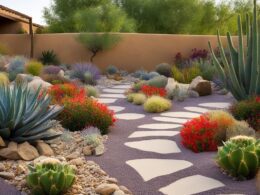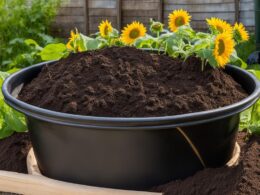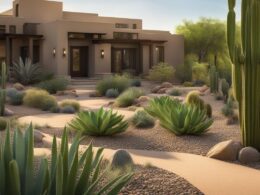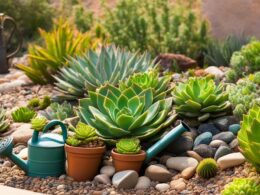Are you a homeowner with a large property looking for an eco-friendly and water-wise gardening solution? Look no further than xeriscape landscape design. This sustainable approach to landscaping is particularly beneficial for large properties, offering a beautiful and environmentally friendly alternative to traditional gardening methods.
Xeriscape designs focus on water conservation and low-maintenance principles, allowing you to create stunning landscapes without excessive water usage or constant upkeep. By incorporating drought-tolerant plants, minimizing supplemental irrigation, and integrating elements such as gravel gardens, rock features, and native plant species, xeriscape designs thrive while reducing your environmental impact.
Key Takeaways:
- Xeriscape design is a sustainable and water-wise gardening approach for large properties.
- It promotes water conservation and reduces maintenance efforts.
- Drought-tolerant plants, gravel gardens, and native species are essential elements of xeriscape designs.
- Xeriscape landscapes are cost-effective, eco-friendly, and support biodiversity.
- Consider using natural materials like stone and gravel for hardscaping features.
Benefits of Xeriscape Landscape Design
Xeriscape landscape design offers numerous benefits for large properties. One of the key advantages is water conservation. By implementing xeriscaping principles, homeowners can significantly reduce their water usage and save up to 5,000-8,000 gallons of water per year compared to traditional landscaping methods.
With xeriscape design, the focus is on using drought-tolerant plants, mulch, and efficient irrigation systems, which minimize water waste. The use of native plants, which are well-adapted to the local climate, reduces the need for excessive watering. Additionally, the incorporation of mulch helps retain soil moisture, reducing evaporation and the need for frequent irrigation.
Aside from water conservation, xeriscape design also offers the benefit of low maintenance. By choosing native plants and natural materials, such as stone or gravel, homeowners can create a landscape that requires less pruning, edging, and fertilization. This not only saves time and effort but also reduces the cost of maintenance in the long run.
Key Benefits of Xeriscape Landscape Design:
- Water conservation
- Low maintenance
- Cost savings
- Eco-friendly
“Xeriscape landscaping can save up to 5,000-8,000 gallons of water per year compared to traditional landscaping.”
Xeriscape Design: A Sustainable Option for Large Properties
In addition to the practical benefits, xeriscape design is also environmentally friendly. By promoting biodiversity and reducing the need for chemical fertilizers and pesticides, xeriscaping creates a healthier ecosystem. The use of native plants encourages the presence of pollinators and wildlife, contributing to the overall balance of the environment.
In conclusion, xeriscape landscape design offers a sustainable and eco-friendly approach to landscaping large properties. With its emphasis on water conservation, low maintenance, and cost savings, xeriscaping provides homeowners with a beautiful and environmentally responsible way to create a stunning landscape that can thrive without excessive water usage.
Key Elements of Xeriscape Landscape Design
Creating an effective xeriscape landscape design for large properties involves incorporating several key elements. Native plants are a crucial component, as they are well-adapted to the local climate and require minimal water once established. By using native plants, you can ensure that your landscape is sustainable and resilient, even in periods of drought. Additionally, native plants provide habitat for local wildlife and contribute to the overall biodiversity of your property.
Mulch is another important element of xeriscape design. Applying a layer of organic mulch around your plants helps conserve soil moisture, suppresses weed growth, and improves soil fertility. It acts as a natural insulator, regulating soil temperature and reducing evaporation. Organic mulches, such as wood chips or compost, also break down over time, enriching the soil with nutrients.
Incorporating gravel gardens into your xeriscape design can also be beneficial, particularly in areas with arid climates. Gravel gardens feature a combination of gravel, rocks, and drought-tolerant plants, creating a visually appealing and low-maintenance landscape. Gravel serves as a mulch substitute, preventing soil erosion and reducing water loss through evaporation. It also provides a well-drained environment for plants that thrive in dry conditions. Consider incorporating different textures and colors of gravel to add visual interest to your design.
Hardscaping features such as paths, walkways, and seating areas can enhance both the functionality and aesthetics of your xeriscape design. Utilizing natural materials like stone, gravel, or concrete pavers can complement the overall theme of water-wise gardening. These hardscaping elements can provide structure and define different areas within your landscape, while also facilitating proper drainage. Consider integrating seating areas where you can relax and enjoy your xeriscape oasis.
Selecting the Right Native Plants
When choosing native plants for your xeriscape design, consider their water requirements, growth habits, and tolerance to your specific local conditions. Look for plants that are labeled as drought-tolerant or low-water-use. Some examples of commonly used native plants for xeriscaping include yucca, agave, lavender, sage, and ornamental grasses. These plants can thrive with minimal water once established and provide year-round beauty to your landscape.
Implementing Proper Irrigation Techniques
Efficient irrigation is essential in xeriscape design to ensure that water is used judiciously. Drip irrigation systems are highly recommended for xeriscaping, as they deliver water directly to the plants’ root zones, reducing water waste from evaporation. Install timers and moisture sensors to automate the irrigation process and prevent overwatering. Pay attention to the specific water requirements of each plant and group them accordingly to create water-efficient zones within your landscape.
- Choose native plants that are well-adapted to your local climate and soil conditions.
- Apply a layer of organic mulch to retain soil moisture and suppress weed growth.
- Create visually appealing gravel gardens using drought-tolerant plants and rocks.
- Incorporate hardscaping elements like paths and seating areas using natural materials.
- Select drought-tolerant native plants such as yucca, agave, lavender, and ornamental grasses.
- Install efficient drip irrigation systems and automate watering with timers and moisture sensors.
Selecting Plants and Hardscaping for a Xeriscape Design
When it comes to creating a xeriscape design for your large property, selecting the right plants and incorporating hardscaping elements are crucial steps. By strategically choosing drought-tolerant plants and thoughtfully planning your hardscape layout, you can achieve a beautiful and sustainable landscape that thrives even with minimal water usage. Here are some key considerations to keep in mind:
Selecting Drought-Tolerant Plants
One of the foundations of a successful xeriscape design is choosing plants that can withstand dry conditions. Opt for drought-tolerant species that are native to your region, as they have already adapted to the local climate and are more likely to thrive. Consider incorporating a mix of herbaceous perennials, Mediterranean plants, succulents, and low-growing groundcovers. These types of plants have evolved to store water and withstand prolonged periods of drought, making them ideal choices for xeriscaping.
Incorporating Hardscaping Elements
Hardscaping elements not only enhance the visual appeal of your xeriscape design but also serve functional purposes. When incorporating hardscaping into your landscape, prioritize natural materials like stone, gravel, or concrete pavers. These materials not only complement the overall aesthetic but also provide excellent drainage. Carefully plan the layout of paths, walkways, and seating areas to ensure optimal flow and accessibility throughout your property. By integrating hardscaping elements thoughtfully, you can create a cohesive and visually pleasing landscape that requires minimal maintenance.
Considering Maintenance Requirements
While selecting plants and hardscaping elements, it’s important to consider the maintenance requirements of each. Choose plants that fit your desired level of maintenance, whether it be low, medium, or high. Additionally, hardscaping features should be designed for easy upkeep and longevity. By aligning the maintenance needs of your plants and hardscaping features, you can ensure that your xeriscape design remains beautiful and sustainable in the long run.
By carefully selecting plants and incorporating well-designed hardscaping elements, you can create a stunning xeriscape design for your large property. Remember to choose drought-tolerant species, utilize natural materials in your hardscaping, and consider the maintenance requirements of your chosen elements. With these considerations in mind, your xeriscape design will not only thrive but also contribute to water conservation and sustainability.
Can Xeriscaping Techniques for Home Gardens be Applied to Large Properties?
Yes, xeriscaping tips for gardens can certainly be applied to large properties. By utilizing drought-resistant plants, efficient irrigation systems, and mulching techniques, large properties can cut down on water usage and maintenance costs while still maintaining a lush and beautiful landscape.
Conclusion
In conclusion, xeriscape landscape design is an ideal solution for creating sustainable and eco-friendly landscapes on large properties. By implementing water-wise gardening techniques and utilizing native plants, homeowners can achieve beautiful landscapes while conserving water resources. Xeriscape designs are particularly well-suited for large properties, as they reduce maintenance efforts and promote the overall health and biodiversity of the environment.
With its emphasis on water conservation, xeriscape design offers a practical and cost-effective solution for large property owners. By incorporating elements such as mulch, gravel gardens, and hardscaping features, homeowners can create visually appealing landscapes that require minimal water usage and maintenance. This not only saves water but also reduces maintenance costs in the long run.
In addition to its practical advantages, xeriscape landscape design contributes to sustainable landscaping practices. By using drought-tolerant plants and minimizing the need for chemical fertilizers and pesticides, xeriscaping helps protect the environment and create habitats for pollinators and wildlife. The combination of native plants and hardscaping elements creates a harmonious balance between aesthetics and functionality, resulting in a visually pleasing and water-wise landscape.
In conclusion, xeriscape design is a smart choice for large property owners looking for a sustainable and visually appealing landscape. By applying water-wise gardening techniques, utilizing native plants, and incorporating hardscaping features, you can create a beautiful, low-maintenance, and eco-friendly landscape that enhances the overall value and enjoyment of your large property.











